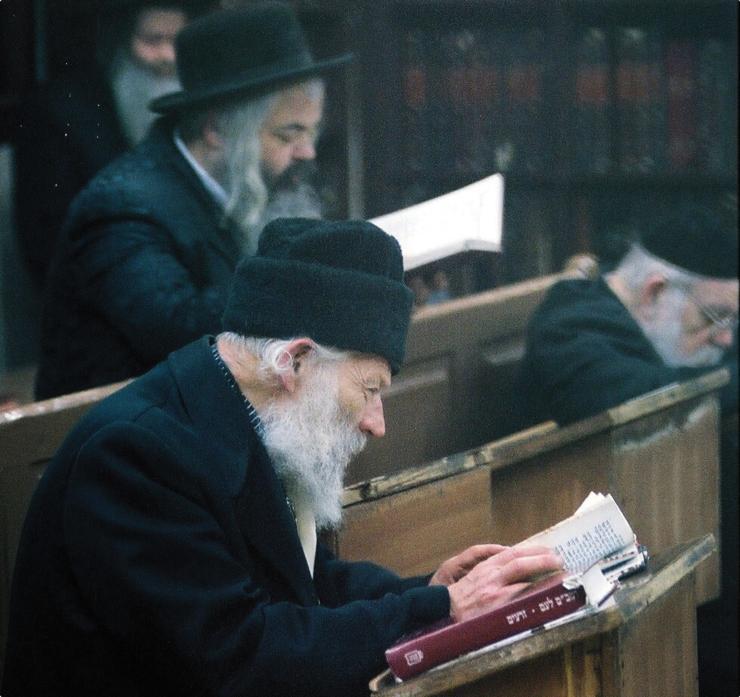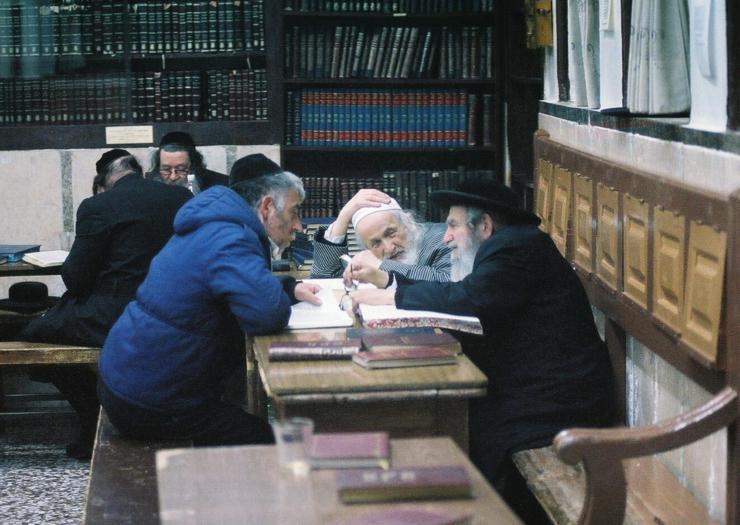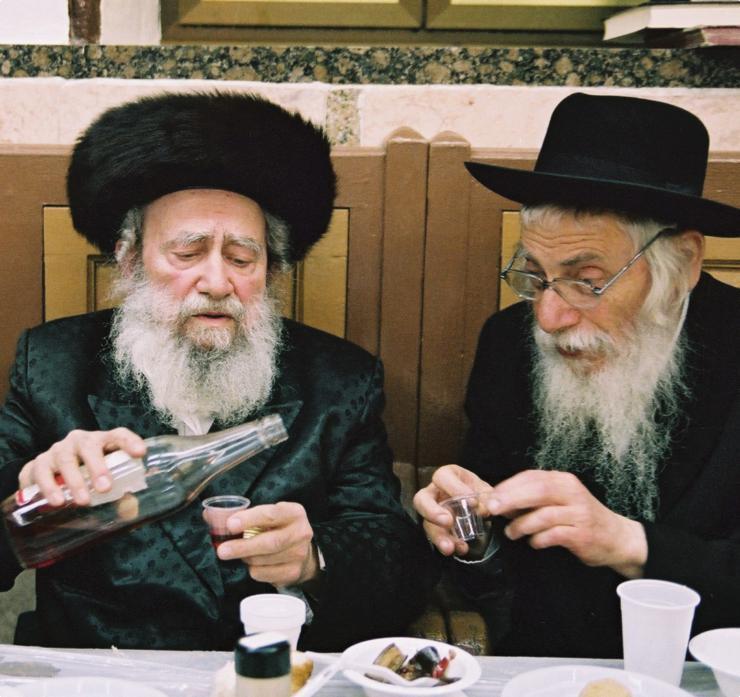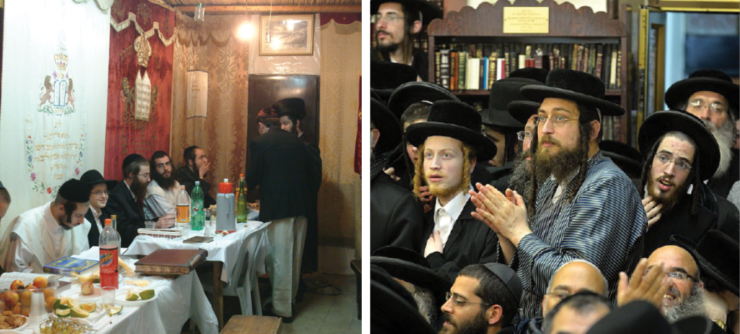A Peak Inside the Baal HaTanya Shul in Meah Shearim
From Beis Moshiach Magazine: For Asara B’Teves, the day Yerushalayim’s walls were breached, we went out to scout one of Yerushalayim’s gems — one of the oldest Chabad Shuls in Eretz Yisrael with a rich history of Avodas Hashem • Full Article
By Menachem Ziegelbaum, Beis Moshiach Magazine
For Asara B’Teves, the day Yerushalayim’s walls were breached, we went out to scout one of Yerushalayim’s gems — one of the oldest Chabad Shuls in Eretz Yisrael with a rich history of Avodas Hashem.
The Place
The Ohel Yitzchok Chabad shul, known as the Baal HaTanya shul, on Rechov Baal HaTanya in the Meah Shearim neighborhood of Yerushalayim, next to the Meah Shearim shuk.
A Quick Look
The shul is furnished with ancient furnishings and the ceiling is decorated with designs that were restored twenty years ago. An especially beautiful aron kodesh, similar to ancient ones in other shuls in the area. On either side are white stone pillars with wood carvings of grapevines, grapes and flowers in vases.
The Home of the First Chassidim
The Baal HaTanya shul was founded in 5659/1899, 124 years ago. In its time, it was the only shul for all the Chabad Chassidim in Yerushalayim outside the walls of the Old City. Today, it is one of the oldest Chabad shuls in Eretz Yisrael. Its walls have absorbed the fragrance of bygone generations and every nook and cranny is redolent of the elders of yore.



A man by the name of R’ Yitzchok from Königsberg (in Germany) donated most of the money for its construction and it was named “Ohel Yitzchok” for him.
It was Rabbi Zev Dov Slonim a’h who, in his youth, thought it was fitting that the street that the Chabad shul is on and where the Slonim family, descendants of the Baal HaTanya, live, be named for him. He put his idea to paper and submitted it to the municipality which accepted it, without committees and a team of advisors, and the street was named “Baal HaTanya.”
During the riots before the War of Independence, the shul hosted the Lubavitch Toras Emes yeshiva, which intensified the activities of the shul. Chabad Chassidus in Yerushalayim blossomed and spread the wellsprings east and west.
After new neighborhoods were built in Yerushalayim, more Chabad shuls were founded but Chabad farbrengens and events are still held, till today, in the first Chabad shul.
Deep Roots
The members of the old yishuv and important personalities from later periods who attended the shul, shed their grace upon the place. The special flavor of the earlier generation is preserved by Chabad Chassidim whose roots are planted in Yerushalayim. Foreign or new winds do not enter here since the running of the shul continues as it always did.



Over the years, the shul has hosted distinguished Chabad Chassidim such as: R’ Chaim Dov Chaimson, R’ Avrohom Moshe Kirschenbaum – shliach tzibbur, baal tokeia and baal korei for many years. R’ Nachum Shmaryahu Sossonkin – rav in Russia and later in Yerushalayim. The mashpiim: R’ Dovid Goldberg, R’ Yehoshua Lipkin, R’ Moshe Weber, R’ Moshe Yaakov Farber, R’ Yaakov Henkin – who knew all of Mishnayos by heart. R’ Yehuda Shapira also knew all of Mishnayos by heart and constantly murmured them quietly. R’ Nissan Horowitz – he always davened shacharis with great concentration until two in the afternoon. The gaon, Rabbi Shlomo Yosef Zevin – rav of the shul, regular mispalel and darshan. R’ Zelig Slonim – mashpia and director of Kollel Chabad, who accomplished a lot for inyanei Chabad in Yerushalayim and for Shechunas Chabad. His brother, R’ Yehuda Leib Slonim who devotedly ran the shul from the day it opened for Chassidus Lubavitch, for fifty consecutive years. There were also the mashpia, R’ Pinchas Leibush Hertzl, the mashpia R’ Shimon Yakobovitz, and yibadel l’chaim aruchim R’ Dovid Brand and the devoted gabbai of the shul, R’ Tzvi Chanun.
For over 100 years, a major event takes place for Yud-Tes Kislev in the Ohel Yitzchok shul. The event is attended by Chabad Chassidim, rabbanim from various Chassidic groups, and many Chassidim who sit together at long set tables in a unique and uplifting spirit. The Rebbe sent instructions and blessings to the rabbanim and gabbaim of the shul who would report to him with details of the farbrengen.
The following are brief recollections written by various people who shared their experiences of the shul.
The Mashpia’s Tzitzis
Rabbi Chanoch Henoch Zilberstrom:
There is an image engraved in my mind of a Shabbos of my childhood when I davened with my father in the Baal HaTanya shul.
Every day, the mashpia, R’ Shia (Yehoshua) Lipkin, would start his daily avoda at three in the morning. He learned Chassidus for several hours and began davening on his own. On Shabbos, he would go for Shacharis at the Chabad shul in Meah Shearim before the chazan began davening, while he was already up to the middle of Nishmas. You could see on his face that he was in a different world.
His regular place was on the southern side in the middle of the bench with his back to the table and facing the bima. In a state of manifest dveikus, he would continue his davening. When the chazan was up to Shemone Esrei, he would join him. Thus he would combine tefilla with avoda and tefilla with the tzibbur.
That Shabbos, R’ Shia came and sat down as usual and continued davening. My father turned to me and whispered, “R’ Shia’s tzitzis.” I turned and saw that they were touching the floor. I understood that my father wanted me to arrange things to fulfill the halacha (in Shulchan Aruch HaRav, Hilchos Tzitzis, siman 21 65) to avoid this. I thought, how can I, a little boy, go over to the great mashpia to point this out to him? But if my father said so… True, he hadn’t ordered me, but what he said was enough for me to understand what I should do.
I went over quietly and with awe and picked the tzitzis up on to the bench. R’ Shia, although in a state of dveikus, felt it and he opened his eyes and looked at me, nodding his head in thanks.
“This event is so engraved in me that since then, whenever I see tzitzis touching the ground, I feel I must pick them up. This is how my father engraved in us a chinuch for halacha and care in mitzva observance.
Holiness and Purity in Shul
Rabbi Yeshaya Hertzl:
I spent my childhood in the Chabad shul in Meah Shearim. My memories of it are sweet. Engraved in my soul is the fact that the place had an atmosphere of Chassidic holiness which I have not felt in other places.
First and foremost, it was delight to look at the ‘faces’ of the shul which was comprised of ziknei Anash. These were towering figures like the geonim Rabbi Nachum Shmaryahu Sossonkin, Rabbi Shlomo Yosef Zevin, Rabbi Zelig Slonim, and others. What a pleasure it was to hear the mashpia, R’ Shia Lipkin or my uncle, R’ Moshe Weber at farbrengens. There were also farbrengens of R’ Dovid Goldberg, one of the talmidim of the mashpia, R’ Alter Simchovitz.
Till today, I can picture R’ Dovid Goldberg farbrenging at the Simchas Beis HaShoeiva in the shul’s sukka. He would repeat again again what it says in the shiur Tanya of that day, “My beloved and dear ones,” as the Alter Rebbe says to the Chassidim, “I beg again and again that each of you exert himself with all his heart and soul to firmly implant in his heart a love for his fellow Jew, and, in the words of Scripture, ‘let none of you consider in your heart what is evil for his fellow.’ Not only not to think it, which could mean actually formed thought, but that you should never consider it.
As R’ Dovid repeated these words with face aflame, he banged on the table and urged everyone to work on themselves in this matter.



I remember another farbrengen of his, after he returned from the Rebbe’s court and he sweetly repeated a sicha of the Rebbe about the names of the tribes, as he described how the Rebbe explained each name and their unique form of avodas Hashem.
He was a clerk by profession but was a Chassid – a pnimi, who davened every day with avoda and all the more so on Shabbos.
Another image in my mind, one of many: every Friday, you could see the great Chassidim arriving at shul. Some of them weren’t quite Chabad Chassidim but would go to the Baal HaTanya shul. In my mind’s eye I can still picture those righteous and holy Jews who found their place to daven with holiness and deveikus in our Chabad shul.
Another Dimension Of the Baal Ha’Tanya Shul
Avrohom (Anthony) Dubovsky, Professor of Architecture from California who went to Eretz Yisrael as a tourist in the spring of 5751. He wrote his impressions in English in the book Jerusalem: To Know By Living:
“R’ [Aharon Mordechai] Zilberstrom was not an ordinary man. I would see him a lot in the Baal HaTanya shul in the late afternoon, learning with his chavrusa, R’ [Shimon] Yakobovitz, bent over the Gemara, the lenses of his thick glasses inches from the pages of small text. Perhaps I would not have noticed him among the rest of the older Chassidim if not for someone drawing my attention to him.
“I even had the privilege of learning with him, Shabbos morning, before the davening as we opened the large sifrei Chassidus on one of the tables covered in white. R’ Zilberstrom would slowly go over the verses, reading them out loud, lost in thought, and then would pause a moment, raising his head to explain. Those moments were wonderful, deep moments of emotion and understanding. I so valued those hours in his presence. We would sit together, R’ Zilberstrom and a group of another three or four, for about an hour. Toward the end, Hershel the gabbai [R’ Hershel (Tzvi) Chanun, the shamash of the shul] would appear with a cup of tea for each of us. Then we would continue as we sipped the tea.



One morning, Rabbi Moshe Weber appeared in shul and without a word, R’ Zilberstrom gave over the shiur to him, out of respect for his age and scholarship. As I digested the meaning of the gesture (R’ Moshe was esteemed among the Chabad Chassidim), I was sorry that we had lost out on R’ Zilberstrom’s train of thought.
He would sit with us for the third Shabbos meal only rarely, he would place himself at one of the shtenders on the side with an open Gemara in front of him, learning quietly as we enjoyed the challa and herring and cups of tea. Then, most of the time, one of the young bachurim would join him, bent over the same Gemara, their heads together, and R’ Zilberstrom would explain the sugya.
“When you saw R’ Aharon Mordechai explaining another dimension of the Baal HaTanya, within the old shul, you knew that the two were intertwined, the man and the place, just like spices are an inseparable part of the food.”
More Than 100 Years of Yud-Tes Kislev
Yisroel Goldstein, resident of the neighborhood
It was four in the morning, very close to dawn, when the over-six-hour long farbrengen ended. If Eretz Yisrael is the heart of the world, and Yerushalayim is the heart of Eretz Yisrael, then Meah Shearim is the heart of Yerushalayim, and the old Chabad shul is the heart-of-hearts of Yerushalayim. It is fitting that this place would mark the end of the hundreds of Yud-Tes Kislev gatherings held around the world.
The place: The old sanctuary of the Chabad shul on 6 Baal HaTanya Street in Meah Shearim, Yerushalayim. The time: Motzoei Shabbos, Chof Kislev.



The walls of the Chabad shul in Meah Shearim were too narrow to contain the thousands of visitors. As a result, there were many who crowded the doorways. Loudspeakers conveyed the goings-on in shul to the outside.
In the shul itself, numerous people crowded together and avidly took in the Chassidus that flowed from the mouths of the regular mashpiim of the shul as well as the celebrated guest speakers, who came to celebrate the Yud-Tes Kislev farbrengen that was an unbroken tradition for more than 100 years!
The broad range of demographics among the participants included: local Yerushalmis whose presence stood out. There were those who wore knitted kippot who came from near and far and those from Litvishe yeshivos who also stood out. Then there were the tmimim who wanted to attend one of the most unique and oldest farbrengens in the annals of Chabad in Eretz Yisrael.
After the siyumim and hadranim of Yud-Tes Kislev, the strains of the Alter Rebbe’s niggun began to soar through the hall. The atmosphere was electric as the voices rose and the inspiration surged. How magnificent it was to see the Rebbe’s secretary, Rabbi Groner, among those farbrenging along with ziknei ha’Chassidim and thousands of young men and bachurim, all joining as one in a niggun about which it was promised that no person would ever sing it without experiencing a thought of teshuva. If you weren’t there, you will never understand it. Chassidim sat in the shul named for the Baal HaTanya and told of the Rebbe’s release from jail all night until the talmidim came and said: Raboseinu, the time has come for the morning Shema.



View From the Women’s Section
R. Friedman:
I would walk to the Baal HaTanya shul in my childhood years, among the alleyways of Meah Shearim paved with the Yerushalmi cobblestones.
The shuk, which bustled with life all week, was empty on the Yomim Noraim and only the sound of prayer from the surrounding shuls reverberated.
We went to daven early in the morning while the chill was accompanied by the white rays of the Rosh Hashana sun.
The Baal HaTanya shul was enveloped in an age-old mysterious scent, holy and lofty, which inspired yearning. Its thick walls, its chandeliers and furniture, were all of a part with the experience of the prayer. They all shared a common denominator: from the floor to the ceilings, from the narrow steps that led to the women’s section to the convex hollows in the ceiling of the old Yerushalmi construction… The holiness and purity were tangible.
There were righteous women who went to pray there. In wonder I would look at the wrinkled faces of the old ladies who came from far and near, supported by canes, a Nusach Ari Machzor in their hands. In wonder I would observe their prayers and tears, as they raised their hands and clenched fists, as they negotiated, entreated, argued and requested…
*
The magazine can be obtained in stores around Crown Heights. To purchase a subscription, please go to: bmoshiach.org
591
Join ChabadInfo's News Roundup and alerts for the HOTTEST Chabad news and updates!











































